TP Link SafeStream TL-R470T+ Bruksanvisning
Läs gratis den bruksanvisning för TP Link SafeStream TL-R470T+ (118 sidor) i kategorin Router. Guiden har ansetts hjälpsam av 12 personer och har ett genomsnittsbetyg på 4.6 stjärnor baserat på 6.5 recensioner. Har du en fråga om TP Link SafeStream TL-R470T+ eller vill du ställa frågor till andra användare av produkten? Ställ en fråga
Sida 1/118

TL-R470T+
Load Balance Broadband Router
Rev: 2.0.0
1910010620

-I-
COPYRIGHT & TRADEMARKS
Specifications are subjec is a registered trademark of t to change without notice.
TP-LINK TECHNOLOGIES CO., LTD. Other brands and product names are trademarks of their
respective holders.
No part of the specifications may be reproduced in any form or by any means or used to make any
derivative such as translation, transformation, or adaptation without permission from TP-LINK
TECHNOLOGIES CO., LTD. Copyright © 2012 TP-LINK TECHNOLOGIES CO., LTD. All rights
reserved.
http://www.tp-link.com
FCC STATEMENT
This equipment has been tested and found to comply with the limits for a Class A digital device,
pursuant to part 15 of the FCC Rules. These limits are designed to provide reasonable protection
against harmful interference when the equipment is operated in a commercial environment. This
equipment generates, uses, and can radiate radio frequency energy and, if not installed and used in
accordance with the instruction manual, may cause harmful interference to radio communications.
Operation of this equipment in a residential area is likely to cause harmful interference in which case
the user will be required to correct the interference at his own expense.
This device complies with part 15 of the FCC Rules. Operation is subject to the following two
conditions:
1) This device may not cause harmful interference.
2) This device must accept any interference received, including interference that may cause
undesired operation.
Any changes or modifications not expressly approved by the party responsible for compliance could
void the user’s authority to operate the equipment.
CE Mark Warning
This is a class A product. In a domestic environment, this product may cause radio interference, in
which case the user may be required to take adequate measures.

-II-
CONTENTS
Package Contents..................................................................................................................1
Chapter 1 About this Guide ...................................................................................................2
1.1 Intended Readers ..................................................................................................................2
1.2 Conventions ...........................................................................................................................2
1.3 Overview of this Guide ...........................................................................................................2
Chapter 2 Introduction ..........................................................................................................4
2.1 Overview of the Router ..........................................................................................................4
2.2 Features.................................................................................................................................5
2.3 Appearance............................................................................................................................6
2.3.1 Front Panel ................................................................................................................6
2.3.2 Rear Panel.................................................................................................................6
Chapter 3 Quick Installation Guide.........................................................................................8
3.1 Configure PC .........................................................................................................................8
3.2 Login ....................................................................................................................................11
Chapter 4 Configuration......................................................................................................18
4.1 Status ...................................................................................................................................18
4.2 Quick Setup .........................................................................................................................19
4.3 Network................................................................................................................................19
4.3.1 WAN ........................................................................................................................19
4.3.2 LAN..........................................................................................................................37
4.3.3 MAC Address...........................................................................................................41
4.3.4 Switch ......................................................................................................................42
4.4 User Group ..........................................................................................................................48
4.4.1 Group.......................................................................................................................49
4.4.2 User .........................................................................................................................49
4.4.3 View.........................................................................................................................50
4.5 Advanced .............................................................................................................................51

-1-
Package Contents
The following items should be found in your package:
¾ One TL-R470T+ Load Balance Broadband Router
¾ One Power cord
¾ One Ethernet Cable
¾ Quick Installation Guide
¾ Resource CD
Note:
● Make sure that the package contains the above items. If any of the listed items are damaged or
missing, please contact with your distributor.
● The provided power cord may be different due to local power specifications.

-2-
Chapter 1 About this Guide
This User Guide contains information for setup and management of TL-R470T+ Load Balance
Broadband Router. Please read this guide carefully before operation.
1.1 Intended Readers
This Guide is intended for Network Engineer and Network Administrator.
1.2 Conventions
In this Guide the following conventions are used:
¾ The Router or TL-R470T+ mentioned in this Guide stands for TL-R470T+ Load Balance
Broadband Router without any explanation.
¾ Menu Name→ →Submenu Name Tab page indicates the menu structure. Advanced→NAT
→Basic NAT means the Basic NAT page under the NAT menu option that is located under the
Advanced menu.
¾ Bold font indicates a toolbar icon, menu or menu item.
¾ <Font> indicate a button.
Symbols in this Guide:
Symbol Description
Note:
Ignoring this type of note might result in a malfunction or damage to the
device.
Tips:
This format indicates important information that helps you make better use of
your device.
1.3 Overview of this Guide
Chapter 1 About This Guide Introduces the guide structure and conventions.
Chapter 2 Introduction Introduces the features and appearance of TL-R470T+ router.
Chapter 3 Quick Installation Guide Introduces how to log in and set up the Router.
Chapter 4 Configuration Introduces how to configure the Router via Web management page.
Appendix A Hardware
Specifications
Lists the hardware specifications of this Router.

-3-
Appendix B FAQ Provides the possible solutions to the problems that may occur during
the installation and operation of the router.
Appendix C Glossary Lists the glossary used in this guide.

-5-
+ Featured Link Backup to switch all the new sessions from dropped line automatically to another
for keeping an always on-line network.
z Easy-to-use
+ Providing easy-to-use GUI with clear configuration steps and detailed help information for the
users to configure the Router simply.
+ Helping administrators to monitor the whole network status and take actions to malfunctions
according to the recorded log information.
+ Supporting remote management to manage the Router from remote places.
2.2 Features
Hardware
¾ 1 fixed WAN port (port 1), 3 adjustable WAN/LAN ports, 1 fixed LAN port (port 5) and 1 Console
port
¾ Built-in high-quality power supply with non-fan system design for quietness
¾ Possesses standard-sized, 19-inch outfit for standard rack
¾ Supports Professional 4kV common mode
lightning protection
¾ Complies with IEEE 802.3, IEEE 802.3u
¾ Supports TCP/IP, DHCP, ICMP, NAT, NAPT protocols
¾ Supports PPPoE, SNTP, HTTP, DDNS, UPnP, NTP protocols
Basic Functions
¾ Supports Static IP, Dynamic IP, PPPoE/Russian PPPoE, L2TP/Russian L2TP, PPTP/Russian
PPTP, Dual Access, BigPond Internet connections
¾ Supports Virtual Server, Port Triggering, ALG, Static Route
¾ Built-in Switch supporting Port Mirror, Port VLAN, Rate Control and so on
¾ Supports to change the MAC address of LAN and WAN ports
¾ Supports PPPoE Server and E-Bulletin
¾ Supports Logs, Statistics, Time setting
¾ Supports Remote and Web management
¾ Supports Diagnostic (Ping/Tracert) and Online Detection
Traffic Control
¾ Supports Bandwidth Control
¾ Supports Session Limit

-6-
Security
¾ Built-in firewall supporting URL/MAC Filtering
¾ Supports Access Control
¾ Supports Attack Defense
¾ Supports IP-MAC Binding
¾ Supports GARP (Gratuitous ARP)
2.3 Appearance
2.3.1 Front Panel
The front panel of TL-R470T+ is shown as the following figure.
z LEDs
LED Status Indication
On The Router is powered on.
PWR
Off The Router is powered off or power supply is abnormal.
Flashing The Router works properly.
SYS
On/Off The Router works improperly.
Off There is no device linked to the corresponding port.
On (Green/Yellow)
There is a device linked to the corresponding port but no
activity. (Green light indicates the corresponding port is
working as a LAN port, and yellow indicates WAN port.)
Link/Act
(WAN/LAN)
Flashing
(Green/Yellow)
There is an active device linked to the corresponding port.
(Green light indicates the corresponding port is working as a
LAN port, and yellow indicates WAN port.)
2.3.2 Rear Panel
The rear panel of TL-R470T+ is shown as the following figure.

-7-
z AC Power Receptacle
Connect the female connector of the power cord to this power receptacle, and the male connector to the
AC power outlet. Please make sure the voltage of the power supply meets the requirement of the input
voltage (100-240V~ 50/60Hz).
z Reset button
Use the button to restore the Router to the factory defaults. With the Router powered on, use a pin to
press and hold the Reset button (about 5 seconds). If the SYS LED is flashing 5 times in high frequency,
release the Reset button. It means the Router is restored successfully. The default management
address of the Router is http://192.168.0.1, and the default username and the password are both
admin.
z Interface Description
Interface Port Description
WAN 1~4 The WAN port is for connecting the Router to a DSL/Cable
modem or Ethernet by the RJ45 cable.
LAN 2~5 The LAN port is for connecting the Router to the local PCs or
switches by the RJ45 cable.
Note:
Please only use the power cord provided with this Router.

-8-
Chapter 3 Quick Installation Guide
After connecting the TL-R470T+ router into your network, you should configure it. This chapter
describes how to configure the basic functions of your TL-R470T+ Load Balance Broadband Router.
These procedures only take you a few minutes. You can access the Internet via the router immediately
after it has been successfully configured.
3.1 Configure PC
Step 1: Click the Start menu on your desktop, right click My Network Places, and then select
Properties (shown in Figure 3-1).
Figure 3-1

-9-
Step 2: In the next screen, right click Local Area Connection (LAN), and then select Properties.
Figure 3-2
Step 3: In the next screen, select General tab, highlight Internet Protocol (TCP/IP), and then click the
Properties button.
Figure 3-3

-10-
Step 4: Configure the IP address as shown in Figure 3-4. After that, click OK.
Figure 3-4
Note:
You can configure the PC to get an IP address automatically, select “Obtain an IP address
automatically” and “Obtain DNS server address automatically” in the screen above. For Windows
98 OS or earlier, the PC and router may need to be restarted.
Now, you can run the Ping command in the command prompt to verify the network connection. Please
click the Start menu on your desktop, select run tab, type cmd in the field, and then type ping
192.168.0.1 on the next screen, and then press Enter.
If the result displayed is similar to the screen below, the connection between your PC and the Router
has been established.
Figure 3-5
If the result displayed is similar to the screen shown below, it means that your PC has not connected to
the Router.

-11-
Figure 3-6
You can check it by following the steps below:
Note:
● Is the connection between your PC and the Router correct?
The LEDs of LAN port which you link to the device and the LEDs on your PC's adapter should be lit.
● Is the TCP/IP configuration for your PC correct?
If the Router's IP address is 192.168.0.1, your PC's IP address must be within the range of
192.168.0.2 ~ 192.168.0.254, the gateway must be 192.168.0.1.
3.2 Login
Once your host PC is properly configured, please proceed as follows to use the Web-based Utility:
Start your web browser and type the private IP address of the Router in the URL field:
http://192.168.0.1.
After that, you will see the screen shown and the default below; enter the default User Name admin
Password admin.

-12-
Figure 3-7
Note:
If the above screen (Figure 3-7) does not prompt, it means that your web-browser may be set to a
proxy. Choose Tools menu→Internet Options→ →Connections LAN Settings, in the screen that
appears, cancel the Using Proxy checkbox, and click OK to finish it.
After a successful login, the “Quick Setup” screen will pop up as the shown. If it does not Figure 3-8
prompt, you can click the Quick Setup on the left of the main menu. Then click <Next>.
Figure 3-8 Quick Setup
Select the total number of WAN ports you prefer to use as the Figure 3-9 shown. Then click <Next> to
load the WAN Port screen.

-13-
Figure 3-9 WAN Mode
Select the WAN port you want to use as the Figure 3-10 shown, and then click <Next> to load the
WAN Connection Type screen.
Figure 3-10 WAN Port
Select the connection type provided by your ISP as the Figure 3-11 shown. Three popular types are
provided here. For other connection types, please refer to the 4.3.1 WAN.

-14-
Figure 3-11 WAN Connection Type
1) If you choose PPPoE, you will see the screen as the Figure 3-12 shown. Enter the Account
Name and Password provided by your ISP (Internet Service Provider).
Figure 3-12 WAN Connection Type - PPPoE
Click <Next> to dial up, and the process will take a few minutes. The process of configuring the
network parameters is shown as Figure 3-14. If you close the screen during the process, the
configuration will still be continued in the background.
These fields are case sensitive. If you have difficulty in this process, please contact your ISP.

-16-
Figure 3-15 WAN Connection Type - Static IP
Then click <Next>. The process for configuring the network parameters is shown as Figure 3-16.
If you close the screen during the process, the configuration will still be continued in the
background.
If you have difficulty in this process, please contact your ISP.
Figure 3-16 WAN Connection Type - Static IP Connecting
After that, you will see the next screen. Click <Finish> to complete the quick installation or click
<Continue> to configure other WAN ports.

-17-
Figure 3-17 Configuration Completed

-18-
Chapter 4 Configuration
4.1 Status
The Status page shows the system information, the port connection status and other information
related to this Router.
Choose the menu Status to load the following page.
Figure 4-1 Status

-19-
4.2 Quick Setup
Please refer to the Chapter 3 Quick Installation Guide.
4.3 Network
4.3.1 WAN
4.3.1.1 WAN Mode
TL-R470T+ provides four available WAN ports. You can set the number of WAN ports on this page.
Choose the menu Network→ →WAN WAN Mode to load the following page.
Figure 4-2 WAN Mode
¾ WAN Mode
WAN Ports: Select the total number of WAN ports you prefer to use.
And the Router will adjust the physical ports
accordingly, which can be illustrated on the following
port sketch.
Note:
● By default, TL-R470T+ is set to work in the mode of dual WAN ports.
● Any change to the number of WAN ports may lead to a loss of current configurations. Please be
sure to backup your configurations in advance.
4.3.1.2 WAN1
TL-R470T+ provides the following six Internet connection types: Static IP, Dynamic IP, PPPoE/Russian
PPPoE, L2TP/Russian L2TP, PPTP/Russian PPTP and BigPond. To configure the WAN, please first
select the type of Internet connection provided by your ISP (Internet Service Provider).

-20-
Tips:
● It’s allowed to set the IP addresses of multiple WAN ports within the same subnet. However, to
guarantee a normal communication, make sure that the WAN ports can access the same network,
such as Internet or a local area network.
● The amount of tab pages for WAN port varies with the number of the WAN ports. For the
configurations of the other WAN ports, please refer to the instructions of WAN1.
Choose the menu Network→ →WAN WAN1 to load the configuration page.
1) Static IP
If a static IP address has been provided by your ISP, please choose the Static IP connection type to
configure the parameters for WAN port manually.
Figure 4-3 WAN – Static IP
The following items are displayed on this screen:
¾ Static IP
Connection Type: Select Static IP if your ISP has assigned a static IP address for your
computer.
IP Address: Enter the IP address assigned by your ISP. If you are not clear,
please consult your ISP.
Subnet Mask: Enter the Subnet Mask assigned by your ISP.

-21-
Default Gateway: Optional. Enter the Gateway assigned by your ISP.
MTU: MTU (Maximum Transmission Unit) is the maximum data unit
transmitted by the physical network. It can be set in the range of
576-1500. The default MTU is 1500. You are recommended to keep
the default value if no other MTU value is provided by your ISP.
Primary DNS: Enter the IP address of your ISP’s Primary DNS (Domain Name
Server). If you are not clear, please consult your ISP. It’s not allowed
to access the Internet via domain name if the Primary DNS field is
blank.
Secondary DNS: Optional. If a Secondary DNS Server address is available, enter it.
Upstream Bandwidth: Specify the bandwidth for transmitting packets on the port.
Downstream
Bandwidth:
Specify the bandwidth for receiving packets on the port.
2) Dynamic IP
If your ISP (Internet Service Provider) assigns the IP address automatically, please choose the
Dynamic IP connection type to obtain the parameters for WAN port automatically.

-22-
Figure 4-4 WAN – Dynamic IP
The following items are displayed on this screen:
¾ Dynamic IP
Connection Type: Select Dynamic IP if your ISP assigns the IP address automatically.
Click <Obtain> to get the IP address from your ISP’s server. Click
<Release> to release the current IP address of WAN port.
Host Name: Optional. This field allows you to give a name for the Router. It's
blank by default.
MTU: MTU (Maximum Transmission Unit) is the maximum data unit
transmitted by the physical network. It can be set in the range of
576-1500. The default MTU is 1500. You are recommended to keep
the default value if no other MTU value is provided by your ISP.

-23-
Get IP Address by
Unicast:
The broadcast requirement may not be supported by a few ISPs.
Select this option if you can not get the IP address from your ISP
even with a normal network connection. This option is not required
generally.
Use the following DNS
Server:
Select this option to enter the DNS (Domain Name Server) address
manually.
Primary DNS: Enter the IP address of your ISP’s Primary DNS (Domain Name
Server). If you are not clear, please consult your ISP.
Secondary DNS: Optional. If a Secondary DNS Server address is available, enter it.
Upstream Bandwidth: Specify the bandwidth for transmitting packets on the port.
Downstream
Bandwidth:
Specify the bandwidth for receiving packets on the port.
¾ Dynamic IP Status
Status: Displays the status of obtaining an IP address from your ISP.
z “Disabled” indicates that the Dynamic IP connection type is not
applied.
z “Connecting” indicates that the Router is obtaining the IP
parameters from your ISP.
z “Connected” indicates that the Router has successfully
obtained the IP parameters from your ISP.
z “Disconnected” indicates that the IP address has been
manually released or the Router gets no response from your
ISP. Please check your network connection and consult your
ISP if this problem remains.
IP Address: Displays the IP address assigned by your ISP.
Subnet Mask: Displays the Subnet Mask assigned by your ISP.
Gateway Address: Displays the Gateway Address assigned by your ISP.

-25-
Figure 4-5 WAN - PPPoE
The following items are displayed on this screen:
¾ PPPoE Settings

-26-
Connection Type: Select PPPoE if your ISP provides xDSL Virtual Dial-up connection.
Click <Connect> to dial-up to the Internet and obtain the IP address.
Click <Disconnect> to disconnect the Internet and release the
current IP address.
Account Name: Enter the Account Name provided by your ISP. If you are not clear,
please consult your ISP.
Password: Enter the Password provided by your ISP.
Active Mode: You can select the proper Active mode according to your need.
z Manual: Select this option to manually activate or terminate the
Internet connection by the <Connect> or <Disconnect> button.
It’s optimum for the dial-up connection charged on time.
z Always-on: Select this option to keep the connection always
on. The connection can be re-established automatically when it
is down.
z Time-based: Select this option to keep the connection on
during the Active time you set.
PPPoE Advanced
Settings:
Check here to enable PPPoE advanced settings.
Keep Alive: Once PPPoE is connected, the Router will send keep-alive packets
every "Keep Alive Interval" sec and "Keep Alive Retry Times" to
make sure the connection is still alive. If the Router does not get the
response from ISP after sending keep-alive packets, the Router will
terminate the connection.
MTU: MTU (Maximum Transmission Unit) is the maximum data unit
transmitted by the physical network. It can be set in the range of
576-1492. The default MTU is 1480. You are recommended to keep
the default value if no other MTU value is provided by your ISP.
ISP Address: Optional. Enter the ISP address provided by your ISP. It's null by
default.

-27-
Service Name: Optional. Enter the Service Name provided by your ISP. It's null by
default.
Primary DNS: Enter the IP address of your ISP’s Primary DNS.
Secondary DNS: Optional. Enter the IP address of your ISP’s Secondary DNS.
Secondary Connection: Here allows you to configure the secondary connection. Dynamic IP
and Static IP connection types are provided.
Connection Type: Select the secondary connection type. Options include Disable,
Dynamic IP and Static IP.
IP Address: If Static IP is selected, configure the IP address of WAN port. If
Dynamic IP is selected, the obtained IP address of WAN port is
displayed.
Subnet Address: If Static IP is selected, configure the subnet address of WAN port. If
Dynamic IP is selected, the obtained subnet address of WAN port is
displayed.
Status: Displays the status of secondary connection.
Upstream Bandwidth: Specify the bandwidth for transmitting packets on the port.
Downstream Bandwidth: Specify the bandwidth for receiving packets on the port.
¾ PPPoE Status
Status: Displays the status of PPPoE connection.
z “Disabled” indicates that the PPPoE connection type is
not applied.
z “Connecting” indicates that the Router is obtaining the IP
parameters from your ISP.
z “Connected” indicates that the Router has successfully
obtained the IP parameters from your ISP.
z “Disconnected” indicates that the connection has been

-28-
manually terminated or the Router gets no response from
your ISP. Please ensure that your settings are correct
and your network is connected well. Consult your ISP if
this problem remains.
IP Address: Displays the IP address assigned by your ISP.
Gateway Address: Displays the Gateway Address assigned by your ISP.
Primary DNS: Displays the IP address of your ISP’s Primary DNS.
Secondary DNS: Displays the IP address of your ISP’s Secondary DNS.
4) L2TP
If your ISP (Internet Service Provider) has provided the account information for the L2TP connection,
please choose the L2TP connection type.

-29-
Figure 4-6 WAN - L2TP
The following items are displayed on this screen:
¾ L2TP Settings
Connection Type: Select L2TP if your ISP provides a L2TP connection. Click
<Connect> to dial-up to the Internet and obtain the IP
address. Click <Disconnect> to disconnect the Internet and
release the current IP address.

-32-
5) PPTP
If your ISP (Internet Service Provider) has provided the account information for the PPTP connection,
please choose the PPTP connection type.
Figure 4-7 WAN - PPTP
The following items are displayed on this screen:
¾ PPTP Settings
Connection Type: Select PPTP if your ISP provides a PPTP connection. Click
<Connect> to dial-up to the Internet and obtain the IP

-34-
Default Gateway: If Static IP is selected, configure the default gateway. If
Dynamic IP is selected, the obtained default gateway is
displayed.
Primary DNS/Secondary DNS: If Static IP is selected, configure the DNS. If Dynamic IP is
selected, the obtained DNS is displayed.
Upstream Bandwidth: Specify the bandwidth for transmitting packets on the port.
Downstream Bandwidth: Specify the bandwidth for receiving packets on the port.
¾ PPTP Status
Status: Displays the status of PPTP connection.
z “Disabled” indicates that the PPTP connection type is
not applied.
z “Connecting” indicates that the Router is obtaining the
IP parameters from your ISP.
z “Connected” indicates that the Router has successfully
obtained the IP parameters from your ISP.
z “Disconnected” indicates that the connection has been
manually terminated or the Router gets no response
from your ISP. Please ensure that your settings are
correct and your network is connected well. Consult
your ISP if this problem remains.
IP Address: Displays the IP address assigned by your ISP.
Primary DNS: Displays the IP address of your ISP’s Primary DNS.
Secondary DNS: Displays the IP address of your ISP’s Secondary DNS.

-35-
6) BigPond
If your ISP (Internet Service Provider) has provided the account information for the BigPond
connection, please choose the BigPond connection type.
Figure 4-8 WAN – Bigpond
The following items are displayed on this screen:
¾ BigPond Settings
Connection Type: Select BigPond if your ISP provides a BigPond connection. Click
<Connect> to dial-up to the Internet and obtain the IP address. Click
<Disconnect> to disconnect the Internet and release the current IP
address.
Account Name: Enter the Account Name provided by your ISP. If you are not clear,
please consult your ISP.

-36-
Password: Enter the Password provided by your ISP. If you are not clear, please
consult your ISP.
Auth Server: Enter the address of authentication server. It can be IP address or
server name.
Auth Domain: Enter the domain name of authentication server. It's only required when
the address of Auth Server is a server name.
Auth Mode: You can select the proper Active mode according to your need.
z Manual: Select this option to manually activate or terminate the
Internet connection by the <Connect> or <Disconnect> button. It’s
optimum for the dial-up connection charged on time.
z Always-on: Select this option to keep the connection always on.
The connection can be re-established automatically when it is
down.
MTU: MTU (Maximum Transmission Unit) is the maximum data unit
transmitted by the physical network. It can be set in the range of
576-1500. The default MTU is 1500.
Upstream/Downstream
Bandwidth:
Specify the Upstream/Downstream Bandwidth for the port. To make
"Load Balance" and "Bandwidth Control" take effect, please set these
parameters correctly.
¾ BigPond Status
Status: Displays the status of BigPond connection.
z “Disabled” indicates that the BigPond connection type is not
applied.
z “Connecting” indicates that the Router is obtaining the IP
parameters from your ISP.
z “Connected” indicates that the Router has successfully obtained
the IP parameters from your ISP.
z “Disconnected” indicates that the connection has been
manually terminated or the Router gets no response from your
ISP. Please ensure that your settings are correct and your

-37-
network is connected well. Consult your ISP if this problem
remains.
IP Address: Displays the IP address assigned by your ISP.
Subnet Mask: Displays the Subnet Mask assigned by your ISP.
Default Gateway: Displays the IP address of the default gateway assigned by your
ISP.
Note:
To ensure the BigPond connection re-established normally, please restart the connection at least 5
seconds after the connection is off.
4.3.2 LAN
4.3.2.1 LAN
On this page, you can configure the parameters for LAN port of this router.
Choose the menu Network→ →LAN LAN to load the following page.
Figure 4-9 LAN
The following items are displayed on this screen:
¾ LAN
IP Address: Enter the LAN IP address of the Router. 192.168.0.1 is
the default IP address. The Hosts in LAN can access
the Router via this IP address. It can be changed
according to your network.
Subnet Mask: Enter the Subnet Mask. The default subnet mask is
255.255.255.0.

-38-
Note:
If the LAN IP address is changed, you must use the new IP address to login to the Router. To
guarantee a normal communication, please be sure that the Gateway address and the Subnet Mask of
the Hosts are consistent with that of the Router accordingly.
4.3.2.2 DHCP
The Router with its DHCP (Dynamic Host Configuration Protocol) server enabled can automatically
assign an IP address to the computers in the LAN.
Choose the menu Network→ →LAN DHCP to load the following page.
Figure 4-10 DHCP Settings
The following items are displayed on this screen:
¾ DHCP Settings
DHCP Server: Enable or disable the DHCP server on your Router. Select Enable to
make the Router automatically assign TCP/IP parameters to the
computers in the LAN.
Start IP Address: Enter the Start IP address to define a range for the DHCP server to
assign dynamic IP addresses. This address should be in the same IP
address subnet with the Router’s LAN IP address. The default
address is 192.168.0.2.
End IP Address: Enter the End IP address to define a range for the DHCP server to
assign dynamic IP addresses. This address should be in the same IP
address subnet with the Router’s LAN IP address. The default
address is 192.168.0.254.

-39-
Lease Time: Specify the length of time the DHCP server will reserve the IP address
for each computer. After the IP address expired, the client will be
automatically assigned a new one.
Default Gateway: Optional. Enter the Gateway address to be assigned. It is
recommended to enter the IP address of the LAN port of the Router.
Default Domain: Optional. Enter the domain name of your network.
Primary DNS: Optional. Enter the Primary DNS server address provided by your
ISP. It is recommended to enter the IP address of the LAN port of the
Router.
Secondary DNS: Optional. If a Secondary DNS Server address is available, enter it.
4.3.2.3 DHCP Client
On this page, you can view the information about all the DHCP clients connected to the Router.
Choose the menu Network→ →LAN DHCP Client to load the following page.
Figure 4-11 DHCP Client
You can view the information of the DHCP clients in this table. Click the Refresh button for the updated
information.
4.3.2.4 DHCP Reservation
DHCP Reservation feature allows you to reserve an IP address for the specified MAC address. The
client with this MAC address will always get the same IP address each time when it accesses the
DHCP server.
Choose the menu Network→ →LAN DHCP Reservation to load the following page.

-40-
Figure 4-12 DHCP Reservation
The following items are displayed on this screen:
¾ DHCP Reservation
MAC Address: Enter the MAC address of the computer for which you want to reserve
the IP address.
IP Address: Enter the reserved IP address.
Description: Optional. Enter a description for the entry. Up to 28 characters can be
entered.
Status: Activate or Inactivate the corresponding entry.
¾ List of Reserved Address
In this table, you can view the information of the entries and edit them by the Action buttons. Up
to 512 DHCP static address entries can be supported for LAN by this Router.
The first entry in Figure 4-12 indicates: The IP address 192.168.0.101 is reserved for the
computer with the MAC address 00-19-66-83-53-CF, and this entry is activated.
Note:
It's recommended that users first bind the IP address and the MAC address in 4.6.1.1 IP-MAC Binding,
then import the entries from the IP-MAC binding table to the List of Reserved Address in buck by
clicking <Import> button in Figure 4-12 DHCP Reservation.

-41-
4.3.3 MAC Address
The MAC (Media Access Control) address, as the unique identifier of the router in network, does not
need to be changed commonly.
Set the MAC Address for LAN port:
In a complex network topology with all the ARP bound devices, if you want to use TL-R470T+ instead
of the current router in a network node, you can just set the MAC address of TL-R470T+’s LAN port the
same to the MAC address of the previous router, which can avoid all the devices under this network
node to update their ARP binding tables.
Set the MAC Address for WAN port:
In the condition that your ISP has of the dial-up device, if you bound the account and the MAC address
want to change the dial-up device to be TL-R470T+, you can just set the MAC address of TL-R470T+’s
WAN port the same to the MAC address of the previous dial-up device for a normal Internet
connection.
Choose the menu Network→MAC Address→MAC Address to load the following page.
Figure 4-13 MAC Address
The following items are displayed on this screen:
¾ MAC Address
Port: Displays the port type of the Router.
Current MAC Address: Displays the current MAC address of the port.

-42-
MAC Clone: It’s only available for WAN port. Click the <Restore Factory MAC>
button to restore the MAC address to the factory default value or
click the <Clone Current PC’s MAC> button to clone the MAC
address of the PC you are currently using to configure the Router.
Then click <Save> to apply.
Note:
To avoid a conflict of MAC address on the LAN, it’s not allowed to set the MAC address of the Router’s
LAN port to the MAC address of the current management PC.
4.3.4 Switch
Some basic switch port management functions are provided by TL-R470T+, which facilitates you to
monitor the traffic and manage the network effectively.
4.3.4.1 Statistics
Statistics screen displays the detailed traffic inform llows you to monitor the ation of each port, which a
traffic and locate faults promptly.
Choose the menu Network→ →Switch Statistics to load the following page.
Figure 4-14 Statistics

-44-
Figure 4-15 Port Mirror
The following items are displayed on this screen:
¾ General
Enable Port Mirror: Check the box to enable the Port Mirror function. If unchecked, it will be
disabled.
Mode: Select the mode for the port mirror function. Options include:
z Ingress: When this mode is selected, only the incoming packets
sent by the mirrored port will be copied to the mirroring port.
z Egress: When this mode is selected, only the outgoing packets sent
by the mirrored port will be copied to the mirroring port.
z Ingress&Egress: When this mode is selected, both the incoming
and outgoing packets through the mirrored port will be copied to the
mirroring port.
¾ Port Mirror
Mirroring Port: Select the Mirroring Port to which the traffic is copied. Only one port can
be selected as the mirroring port.
Mirrored Port: Select the Mirrored Port from which the traffic is mirrored. One or multiple
ports can be selected as the mirrored ports.
The entry in Figure 4-15 indicates: The outgoing packets sent by port 1, port 2, port 3 and port 5
(mirrored ports) will be copied to port 4 (mirroring port).

-45-
Tips:
If both the mirrored port and the mirroring port are the LAN ports, these two LAN ports should be in the
same Port VLAN. For example, if port 3 (the mirroring port) and port 4 (the mirrored port) are the LAN
ports, the Port Mirror function can take effect only when port 3 and port 4 are in the same Port VLAN.
Application Example:
To monitor all the traffic and analyze the network abnormity for an enterprise’s network, please set the
Port Mirror function as below:
1) Check the box before Enable Port Mirror to enable the Port Mirror function and select the
Ingress & Egress mode.
2) Select Port 3 to be the Mirroring Port to monitor all the packets of the other ports.
3) Select all the other ports to be the Mirrored Ports.
4) Click the <Save> button to apply.
4.3.4.3 Rate Control
On this page, you can control the traffic rate for the specific packets on each port so as to manage your
network flow.
Choose the menu Network→ →Switch Rate Control to load the following page.
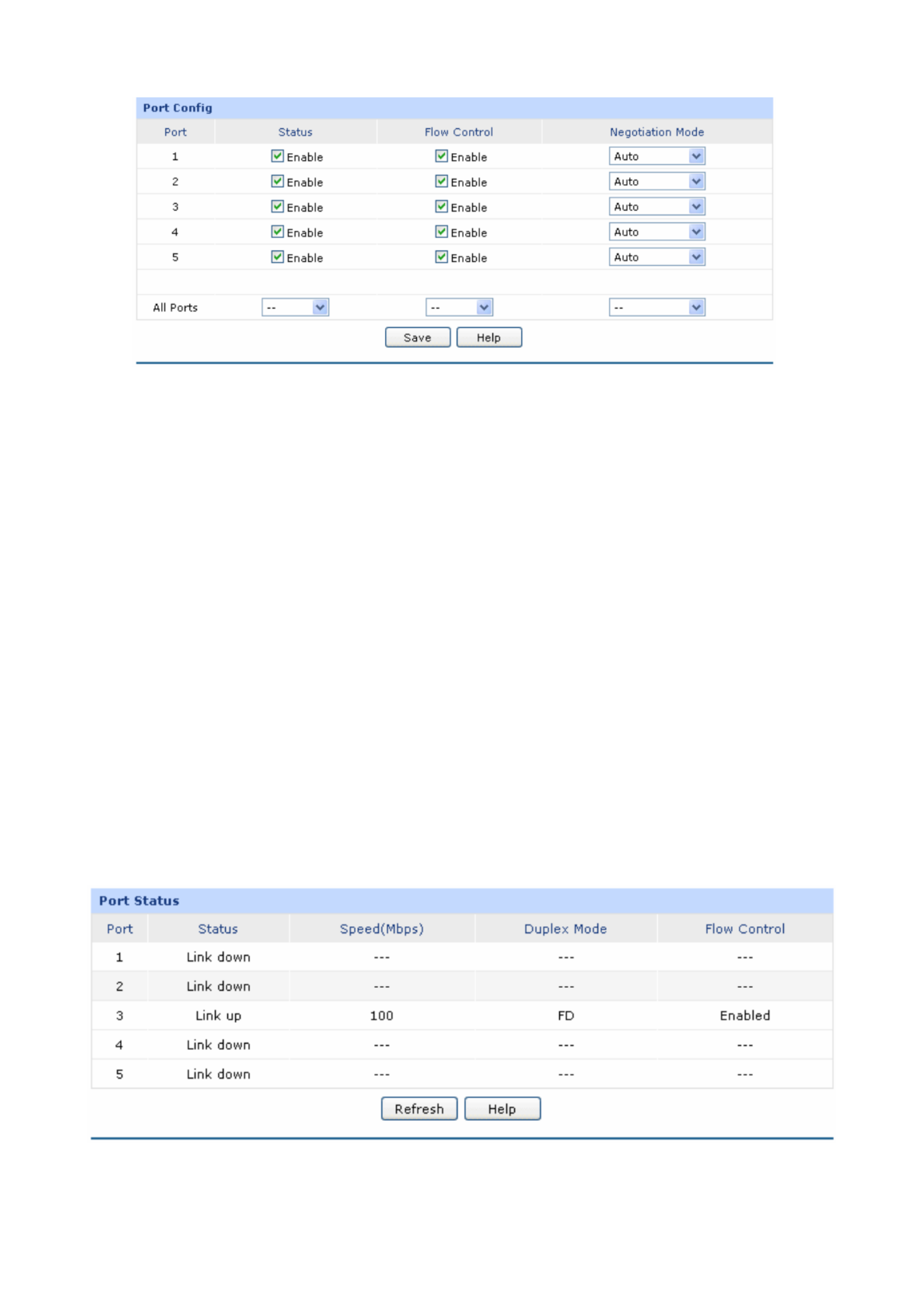
-47-
Figure 4-17 Port Config
The following items are displayed on this screen:
¾ Port Config
Status: Specify whether to enable the port. The packets can be transported via
this port after being enabled.
Flow Control: Allows you to enable/disable the Flow Control function.
Negotiation Mode: Select the Negotiation Mode for the port.
All Ports: Allows you to configure the parameters for all the ports at one time.
4.3.4.5 Port Status
On this page, you can view the current status of each port.
Choose the menu Network→ →Switch Port Status to load the following page.
Figure 4-18 Port Status
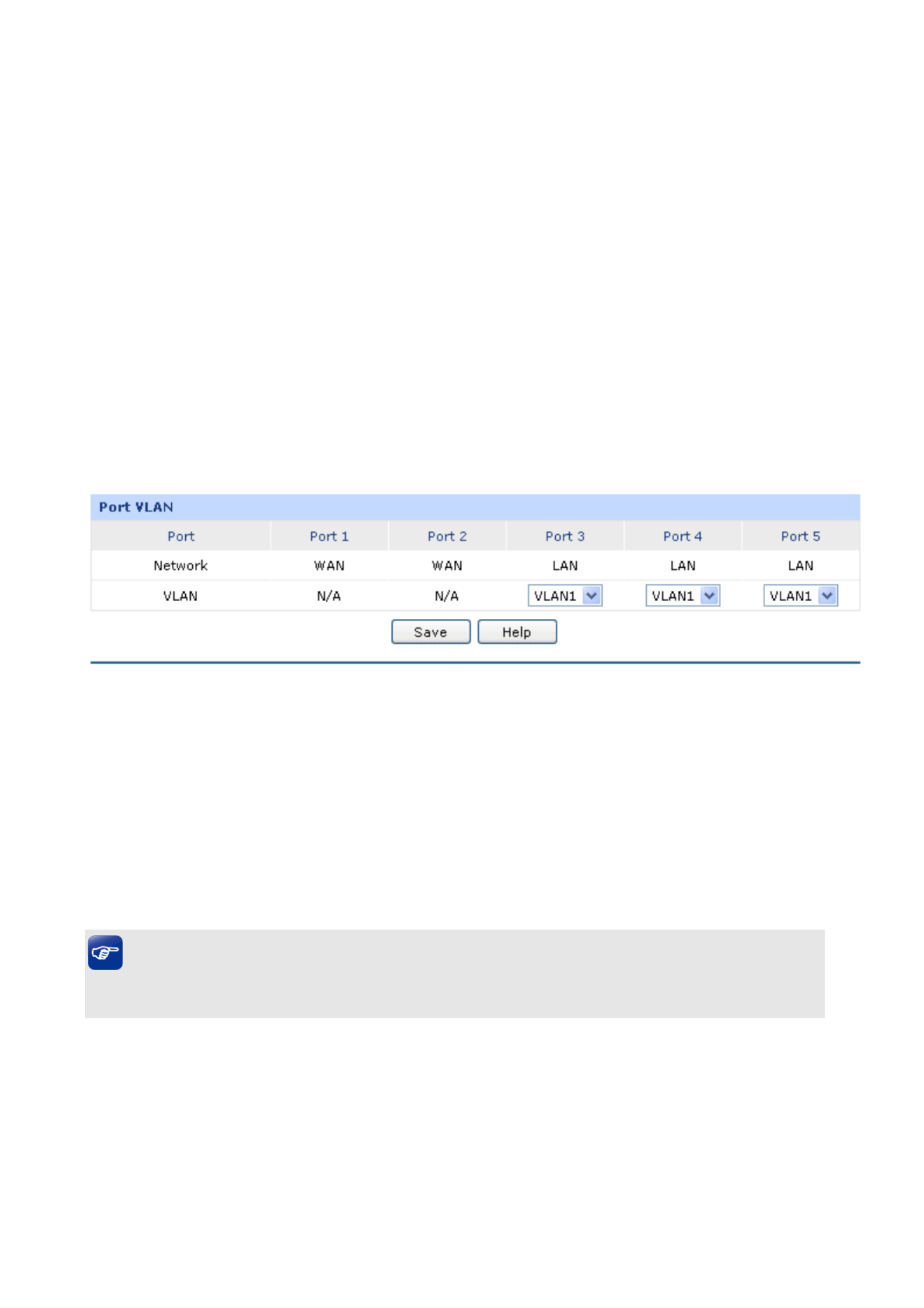
-48-
4.3.4.6 Port VLAN
A VLAN (Virtual Local Area Network) is a network topology configured according to a logical scheme
rather than the physical layout, which allows you to divide the physical LAN into multiple logical LANs
so as to control the communication among the ports.
The VLAN function can prevent the broadcast storm in LANs and enhance the network security. By
creating VLANs in a physical LAN, you can divide the LAN into multiple logical LANs, each of which
has a broadcast domain of its own. Hosts in the same VLAN communicate with one another as if they
are in a LAN. However, hosts in different VLANs cannot communicate with one another directly.
Therefore, broadcast packets are limited in a VLAN.
TL-R470T+ provides the Port VLAN function, which allows you to create multiple logical VLANs for the
LAN ports based on their port numbers.
Choose the menu Network→ →Switch Port VLAN to load the following page.
Figure 4-19 Port VLAN
The following items are displayed on this screen:
¾ Port VLAN
Network: Displays the current logical network of the physical port.
VLAN: Select the desired VLAN for the port.
Tips:
● The Port VLAN can only be created among the LAN ports.
4.4 User Group
The User Group function is used to group different users for unified management, so that you can
perform other applications such as Bandwidth Control, Session Limit, and Access Control etc. on per
group.

-51-
¾
¾
¾
¾¾ View Config
View: Select the desired view for configuration.
User Name: Select the name of the desired User.
Available Group: Displays the Groups that the User can join.
Selected Group: Displays the Groups to which this User belongs.
Group Name: Select the name of the desired Group.
Group Structure: Click this button to view the tree structure of this group. All the members of
this group will be displayed, including Users and sub-Groups. The Group
Names are displayed in bold.
Available Member: Displays the Users and the Groups which can be added into this group.
Selected Member: Displays the members of this group, including Users and Groups.
4.5 Advanced
4.5.1 NAT
NAT (Network Address Translation) is the translation between private IP and public IP, which allows
private network users to visit the public network using private IP addresses.
With the explosion of the Internet, the number of available IP addresses is not enough. NAT provides a
way to allow multiple private hosts to access the public network with one public IP at the same time,
which alleviates the shortage of IP addresses. Furthermore, NAT strengthens the LAN (Local Area
Network) security of the network since the address of LAN host never appears on the Internet.
4.5.1.1 NAT Setup
On this page, you can set up the NAT function.
Choose the menu Advanced→NAT→NAT Setup to load the following page.
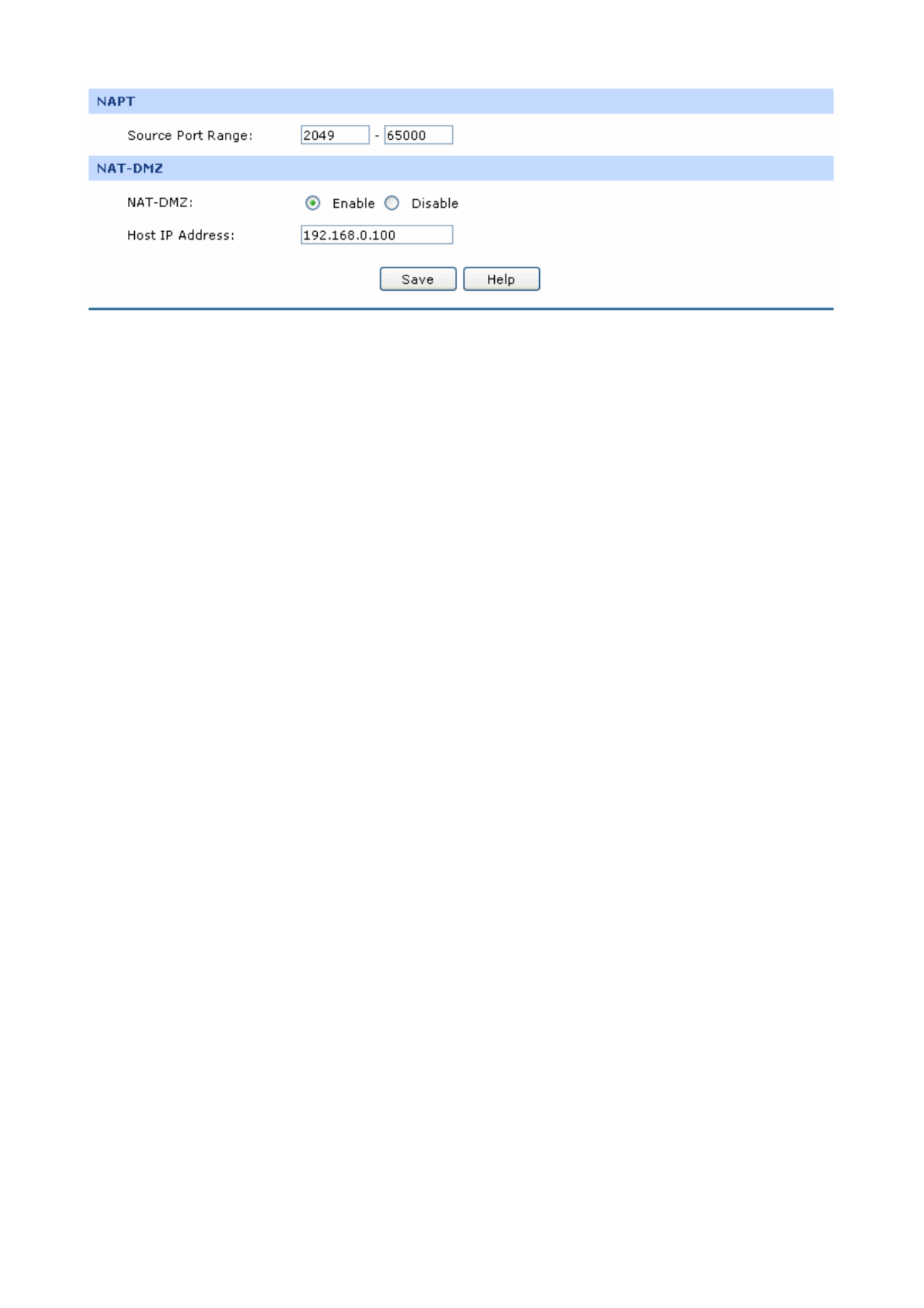
-52-
Figure 4-23 NAT Setup
The following items are displayed on this screen:
¾
¾
¾
¾¾ NAPT
Source Port Range: Enter the source port range between 2049 and 65000, the span of which
must be not less than 100.
¾
¾
¾
¾¾ NAT-DMZ
NAT-DMZ: Enable or disable NAT-DMZ. NAT DMZ is a special service of NAT
application, which can be considered as a default forwarding rule. When
NAT DMZ (Pseudo DMZ) is enabled, all the data initiated by external
network falling short of the current connections or forwarding rules will be
forwarded to the preset NAT DMZ host.
Host IP Address: Enter the IP address of the host specified as NAT DMZ server.
4.5.1.2 Virtual Server
Virtual server can be used for setting up public services in your private network, such as DNS, Email
and FTP. Virtual server can define a service port. All the service requests to this port will be transmitted
to the LAN server appointed by the Router via IP address.
Choose the menu Advanced→NAT→Virtual Server to load the following page.
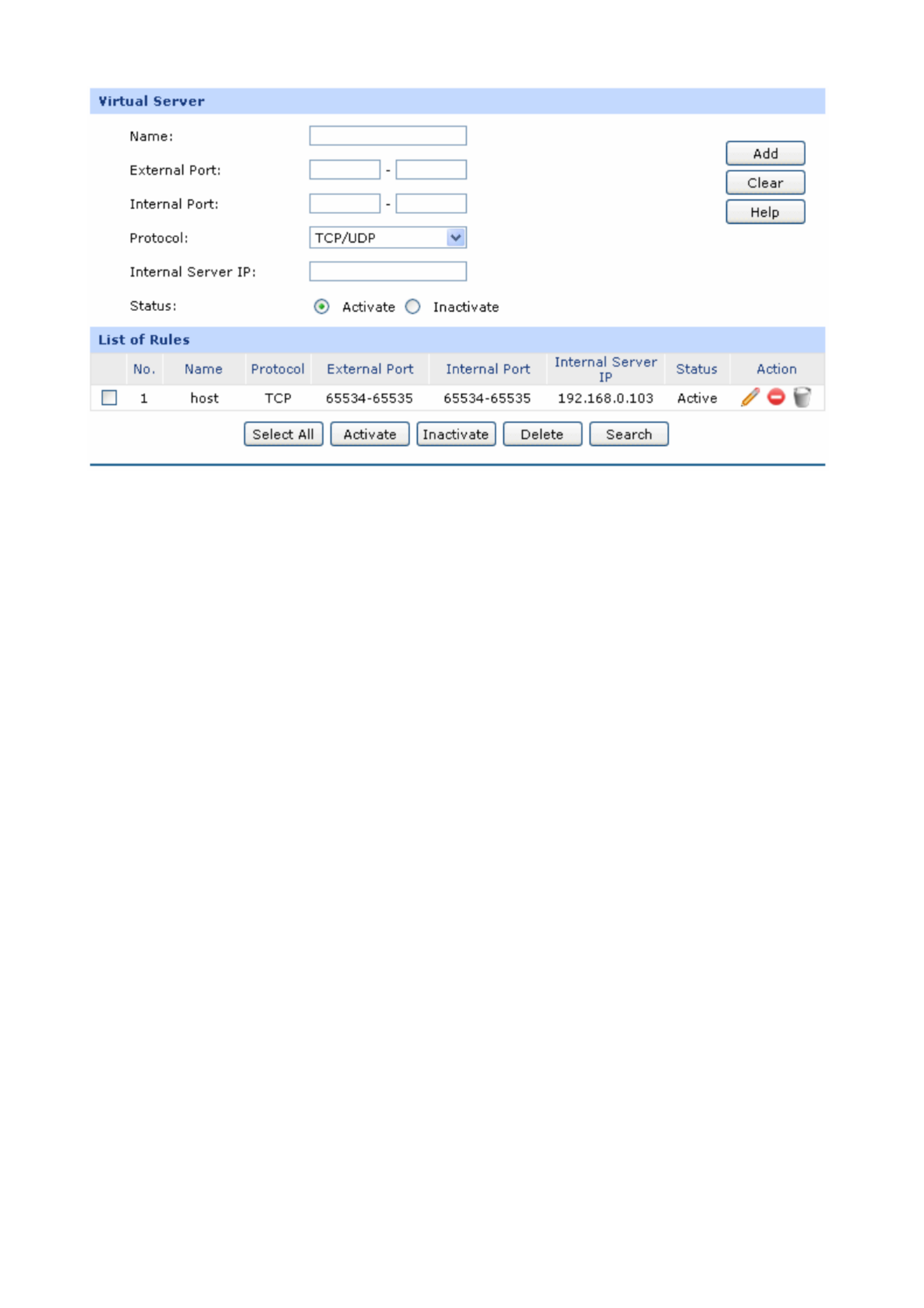
-53-
Figure 4-24 Virtual Server
The following items are displayed on this screen:
¾ Virtual Server
Name: Enter a name for Virtual Server entries. Up to 28 characters can be
entered.
External Port: Enter the service port or port range provided by Router for accessing
external network. All requests from Internet to this service port or port
range will be redirected to the specified server in local network.
Internal Port: Specify the service port of the LAN host as virtual server.
Protocol: Specify the protocol used for the entry.
Internal Server IP: Enter the IP address of the specified internal server for the entry. All
the requests from the Internet to the specified LAN port will be
redirected to this host.
Status: Activate or inactivate the entry.

-55-
¾ Port Triggering
Name: Enter a name for Port Triggering entries. Up to 28 characters can be
entered.
Trigger Port: Enter the trigger port number or range of port numbers. Only when the
trigger port initiates connection will all the corresponding incoming
ports open and provide service for the applications, otherwise the
incoming ports will not open.
Trigger Protocol: Select the protocol used for trigger port.
Incoming Port: Enter the incoming port number or range of port numbers. The
incoming port will open for follow-up connection after the trigger port
initiates connection.
Incoming Protocol: Select the protocol used for incoming port.
Status: Activate or inactivate the entry.
Note:
● The Trigger Port and Incoming Port should be set in the range of 1-65535. The Incoming Port can
be set in a continuous range such as 8690-8696.
● The Router supports up to 16 Port Triggering entries. Each entry supports at most 5 groups of
trigger ports and overlapping between the ports is not allowed.
● Each entry supports at most 5 groups of incoming ports and the sum of incoming ports you set for
each entry should not be more than 100.
¾ List of Rules
In this table, you can view the information of the entries and edit them by the Action buttons.
The first entry in Figure 4-25 indicates that: This is a Port Triggering entry named host1, When the LAN
host initiates a TCP request via port of 5354, the incoming port 5355 will open for TCP and UDP
protocol. This entry is activated.
4.5.1.4 ALG
Some special protocols such as FTP, H.323, SIP, IPsec and PPTP will work properly only when ALG
(Application Layer Gateway) service is enabled.

-56-
Choose the menu Advanced→NAT→ALG to load the following page.
Figure 4-26 ALG
The following items are displayed on this screen:
¾ ALG
FTP ALG: Enable or disable FTP ALG. The default setting is enabled. It is
recommended to keep the default setting if no special
requirement.
H.323 ALG: Enable or disable H.323 ALG. The default setting is enabled.
H.323 is used for various applications such as NetMeeting and
VoIP.
SIP ALG: Enable or disable SIP ALG. The default setting is enabled. It is
recommended to keep the default setting if no special
requirement.
IPsec ALG: Enable or disable IPsec ALG. The default setting is enabled. It is
recommended to keep default if no special requirement.
PPTP ALG: Enable or disable PPTP ALG. The default setting is enabled. It is
recommended to keep default if no special requirement.
4.5.2 Traffic Control
Traffic Control functions to control the bandwidth by configuring rules for limiting various data flows. In
this way, the network bandwidth can be reasonably distributed and utilized.
4.5.2.1 Setup
Choose the menu Advanced→Traffic Control→Setup to load the following page.

-57-
Figure 4-27 Configuration
The following items are displayed on this screen:
¾ General
Disable Bandwidth
Control:
Select this option to disable Bandwidth Control.
Enable Bandwidth
Control all the time:
Select this option to enable Bandwidth Control all the time.
Enable Bandwidth
Control When:
With this option selected, the Bandwidth Control will take effect when the
bandwidth usage reaches the specified value.
¾ Default Limit
Limited Bandwidth: Default Limit applies only for users that are not constrained by Bandwidth
Control Rules. These users share certain bandwidth with upper limit
configured here. Value 0 means all the remained bandwidth is available to
use.

-58-
¾ Interface Bandwidth
Interface: Displays the current enabled WAN port(s). The Total bandwidth is equal to
the sum of bandwidth of the enabled WAN ports.
Upstream
Bandwidth:
Displays the bandwidth of each WAN port for transmitting data. The
Upstream Bandwidth of WAN port can be configured on WAN page.
Downstream
Bandwidth:
Displays the bandwidth of each WAN port for receiving data. The
Downstream Bandwidth of WAN port can be configured on WAN page.
Note:
● The Upstream/Downstream Bandwidth of WAN port you set must not be more than the bandwidth
provided by ISP. Otherwise the Traffic Control will be invalid.
● If there are data flowing into the Router from interface A and out from interface B while the
downstream bandwidth of A is different from the upstream bandwidth of B, then the smaller one
should be considered as the effective bandwidth, and vise versa.
● Click the <View IP Traffic Statistics> button to jump to IP Traffic Statistics page.
4.5.2.2 Bandwidth Control
On this page, you can configure the Bandwidth Control function.
Choose the menu Advanced→Traffic Control→Bandwidth Control to load the following page.
Figure 4-28 Bandwidth Control
The following items are displayed on this screen:

-59-
¾ Bandwidth Control Rule
Direction: Select the data stream direction for the entry. The direction of arrowhead
indicates the data stream direction WAN-ALL means all WAN ports
through which the data flow might pass. Individual WAN port cannot be
selected after WAN-ALL rules are added.
Group: Select the group to define the controlled users.
Mode: Individual: The bandwidth of each user equals to the current bandwidth
of this entry.
Shared: The total bandwidth of all controlled IP addresses equals to the
current bandwidth of this entry.
Guaranteed
Bandwidth (Up):
Specify the Guaranteed Upstream Bandwidth for this entry.
Limited Bandwidth
(Up):
Specify the Limited Upstream Bandwidth for this entry.
Guaranteed
Bandwidth (Down):
Specify the Guaranteed Downstream Bandwidth for this entry.
Limited Bandwidth
(Down):
Specify the Limited Downstream Bandwidth for this entry.
Effective Time: Specify the time for the entry to take effect.
Description: Give a description for the entry.
Status: Activate or inactivate the entry.
¾ List of Rules
You can view the information of the entries and edit them by the Action buttons.
The first entry in Figure 4-28 indicates: The users within group “sales” share the bandwidth and the
Downstream/Upstream Guaranteed Bandwidth is 5000kbps, while the Downstream/Upstream Limited
bandwidth is 10000kbps. This entry takes effect at 8 a.m. to 10 p.m. from Monday to Friday.

-60-
Note:
● The premise for single rule taking the interface for this rule is effect is that the bandwidth of
sufficient and not used up.
● It is impossible to satisfy all the guaranteed bandwidth if the total guaranteed bandwidth specified
by all Bandwidth Control rules for certain interface exceeds the physical bandwidth of this
interface.
4.5.3 Session Limit
The amount of TCP and UDP sessions supported by the Router is finite. If there are some local hosts
transmitting too many TCP and UDP sessions to the public network, the communication quality of the
other local hosts will be affected, thus it is necessary to limit the sessions of those hosts.
4.5.3.1 Session Limit
On this page, you can configure the session limit to specified PCs.
Choose the menu Advanced→Session Limit→Session Limit to load the following page.
Figure 4-29 Session Limit
The following items are displayed on this screen:
¾ General
Enable Session
Limit:
Check here to enable Session Limit, otherwise all the Session Limit
entries will be disabled.
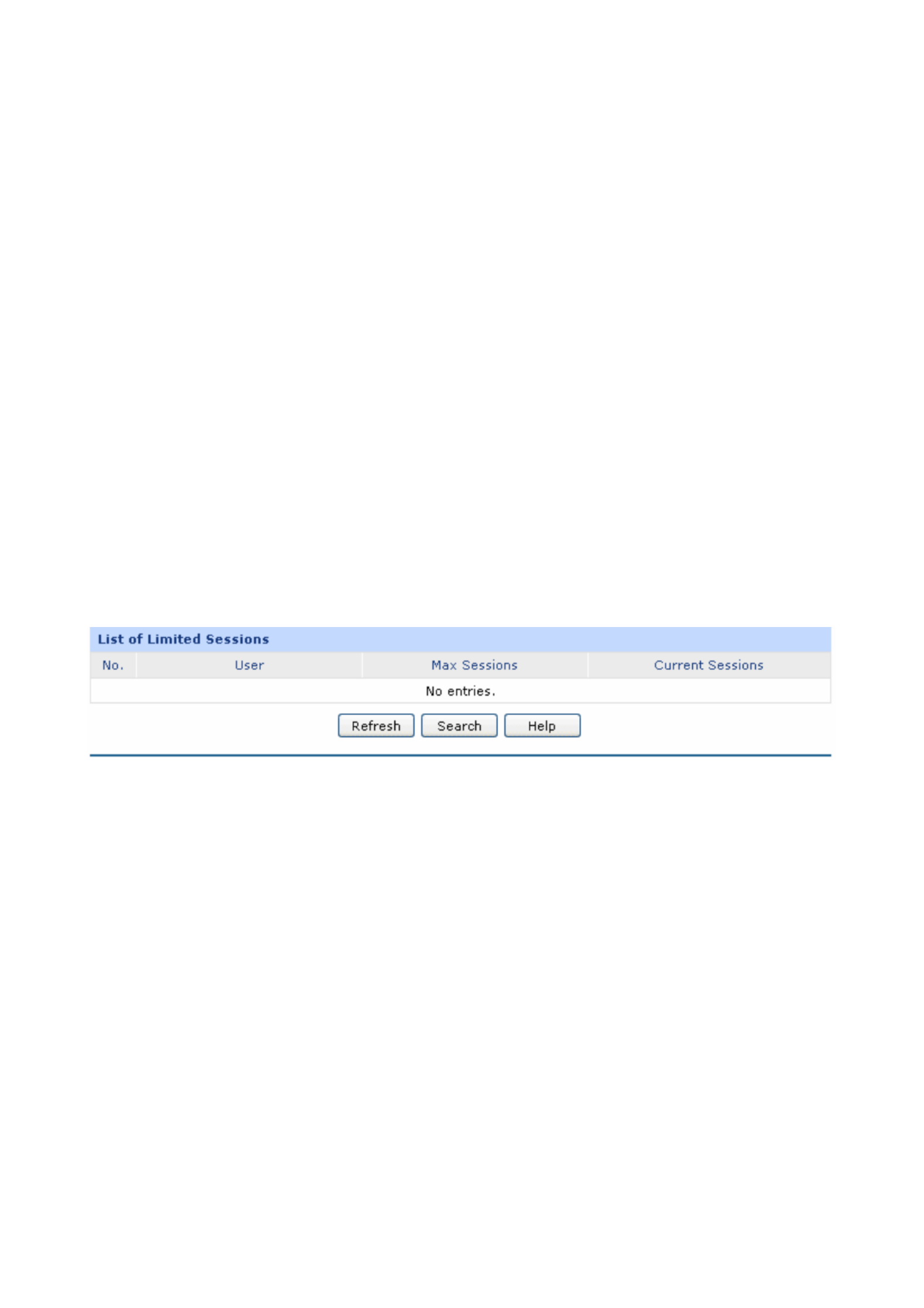
-61-
¾ Session Limit
Group: Select a group to define the controlled user.
Max. Sessions: Enter the max. Sessions for the users.
Description: Give a description for the entry.
Status: Activate or inactivate the entry.
¾ List of Session Limit
You can view the information of the entries and edit them by the Action buttons.
The first entry in ssions for the hosts within group1 Figure 4-29 indicates: The amount of maximum se
is 100 and this entry is enabled.
4.5.3.2 Session List
On this page, you can view the Session Limit information of hosts configured with Session Limit.
Choose the menu Advanced→Session Limit→Session List to load the following page.
Figure 4-30 Session List
In this table, you can view the session limit information of users configured with Session Limit. Click
the <Refresh> button to get the latest information.
4.5.4 Load Balance
On this part, you can configure how the traffic load is shared by the WAN ports to optimize the
resource utilization.
4.5.4.1 Configuration
Choose the menu Advanced→Load Balance→Configuration to load the following page.

-62-
Figure 4-31 Configuration
With the box before Enable Application Optimized Routing checked, the Router will consider the
source IP address and destination IP address of the packets as a whole and record the WAN port they
pass through. And then the packets with the same source IP address and destination IP address or
destination port will be forwarded to the recorded WAN port. This feature is to ensure the
multi-connected applications to work properly.
Check the box before Enable Bandwidth Based Balance Routing and select the WAN port below,
Load Balance of the specified WAN port will be enabled automatically if no routing rules are set.
Then click the <Save> button to apply the settings.
Note:
The WAN ports not connecting to the Internet will not apply Intelligent Balance, please do not select
them.
4.5.4.2 Policy Routing
Policy Routing provides a more accurate way to control the routing based on the policy defined by the
network administrator.
Choose the menu Advanced→Load Balance→Policy Routing to load the following page.
Figure 4-32 Policy Routing

-66-
Figure 4-34 Protocol
The following items are displayed on this screen:
¾ Protocol
Name: Enter a name to indicate a protocol. The name will display in the
drop-down list of Protocol on Access Rule page.
Number: Enter the Number of the protocol in the range of 0-255.
¾ List of Protocol
You can view the information of the entries and edit them by the Action buttons.
Note:
The system predefined protocols cannot be configured.
4.5.5 Routing
4.5.5.1 Static Route
Routing is the process of selecting optimized paths in a network along which to send network traffic.
Static Route is a kind of special routing configured by the administrator, which is simple, efficient, and
reliable.
Commonly used in small-sized network with fixed topology, Static Route does not change along with
the network topology automatically. The administrator should modify the static route information
manually as long as the network topology or link status is changed.
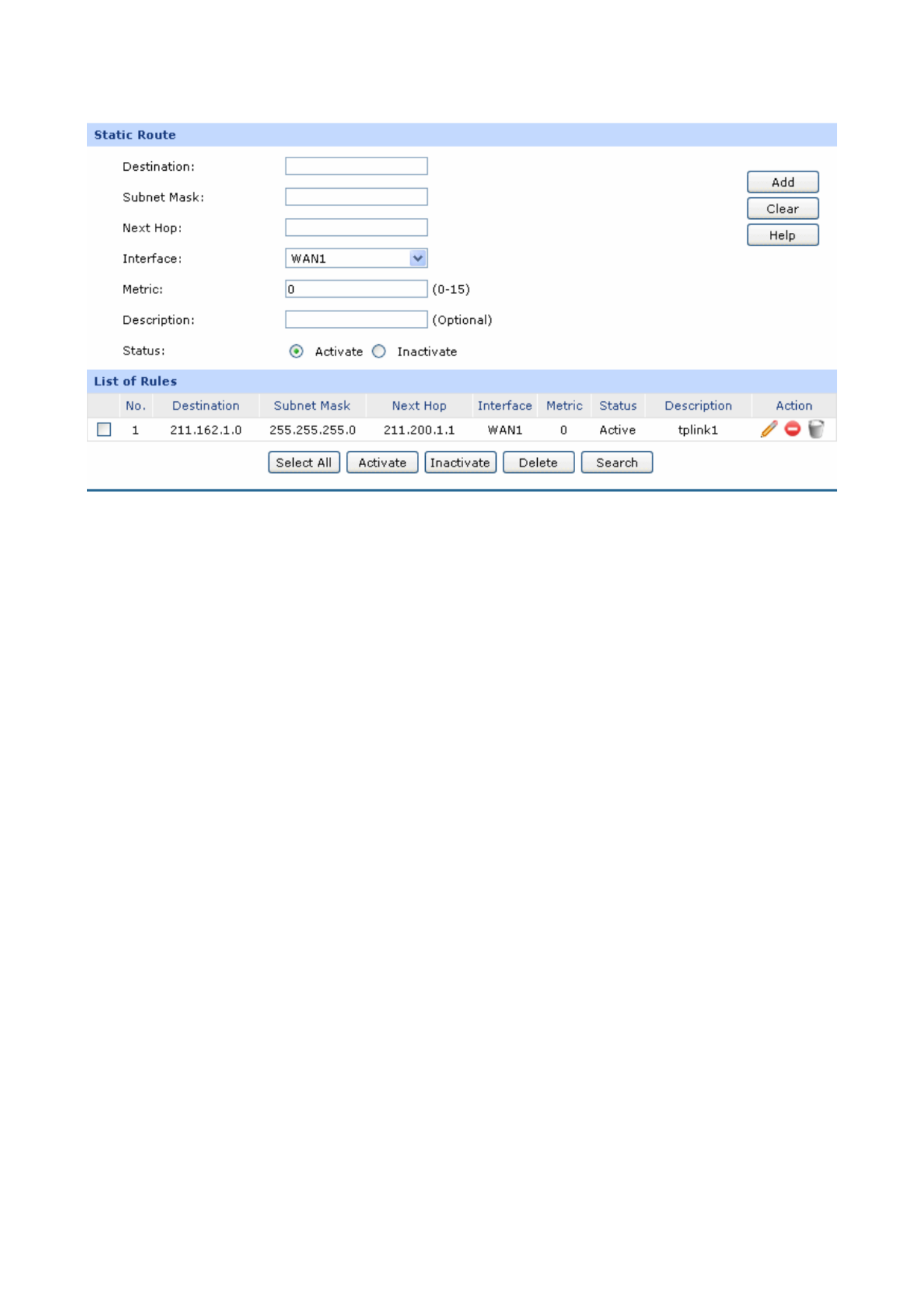
-67-
Choose the menu Advanced→Routing→Static Route to load the following page.
Figure 4-35 Static Route
The following items are displayed on this screen:
¾ Static Route
Destination: Enter the destination host the route leads to.
Subnet Mask: Enter the Subnet Mask of the destination network.
Next Hop: Enter the gateway IP address to which the packet should be sent next.
Interface: Select the physical network interface, through which this route is
accessible.
Metric: Defines the priority of the route. The smaller the value is, the higher the
priority is. The default value is 0. Keep the default value if unnecessary.
Description: Give a description for the entry.
Status: Activate or inactivate the entry.
¾ List of Rules
You can view the information of the entries and edit them by the Action buttons.

-69-
4.6 Firewall
4.6.1 Anti ARP Spoofing
ARP (Address Resolution Protocol) is used to analyze and map IP addresses to the corresponding
MAC addresses so that packets can be delivered to their destinations correctly.
ARP functions to translate the IP address into the corresponding MAC address and maintain an ARP
Table, where the latest used IP address-to-MAC address mapping entries are stored. ARP protocol
can facilitate the Hosts in the same network segment to communicate with one another or access to
external network via Gateway. However, since ARP protocol is implemented with the premise that all
the Hosts and Gateways are trusted, there are high security risks during ARP Implementation
Procedure in the actual complex network.
The attacker may send the ARP spoofing packets with false IP address-to-MAC address mapping
entries, and then the device will automatically update the ARP table after receiving wrong ARP
packets, which results in a breakdown of the normal communication. Thus, ARP defense technology is
generated to prevent the network from this kind of attack.
4.6.1.1 IP-MAC Binding
IP-MAC Binding functions to bind the IP address, MAC address of the host together and only allows the
Hosts matching the bound entries to access the network.
Choose the menu Firewall→ →Anti ARP Spoofing IP-MAC Binding to load the following page.
Figure 4-36 IP-MAC Binding
The following items are displayed on this screen:

-70-
¾ General
It is recommended to check all the options. You should import the IP and MAC address of the host to
List of IP-MAC Binding and enable the corresponding entry before enabling “Permit the packets
matching the IP-MAC Binding entries only”.
When suffered ARP attack, the correct ARP information will be sent to the device suffering attack
initiatively by GARP (Gratuitous ARP) packets, thus the error ARP information of the device will be
replaced. You can set the packets sending rate in the Interval field.
Check the box before Enable ARP Logs, and the Router will send ARP logs to the specified server.
The IP address of server is the Server IP set on 4.8.6 Logs.
¾ IP-MAC Binding
IP Address: Enter the IP Address to be bound.
MAC Address: Enter the MAC Address corresponding to the IP Address.
Description: Give a description for the entry.
Status: Activate or inactivate the entry.
¾ List of Rules
You can view the information of the entries and edit them by the Action buttons.
The first entry in Figure 4-36 indicates: The IP address of 192.168.1.101 and MAC address of
00-19-66-83-53-CF have been bound and this entry is activated.
Note:
If all the entries in the binding list are disabled and “Permit the packets of IP-MAC Binding entries only”
option is selected and saved, t er cannot be login. At the he WEB management page of the Rout
moment, you should restore the Router to factory default and login again.
4.6.1.2 ARP Scanning
ARP Scanning feature enables the Router to scan the IP address and corresponding MAC address
and display them on the List of Scanning Result.
Choose the menu Firewall→ →Anti ARP Spoofing ARP Scanning to load the following page.

-72-
Figure 4-38 ARP List
The configurations for the entries is the same as the configuration of List of Scanning Result on 4.6.1.2
ARP Scanning page.
The unbound IP-MAC inform information or be automatically ation will be replaced by new IP-MAC
removed from the list if it has not been communicated with others for a long time. This period is
regarded as the aging time of the ARP information.
4.6.2 Attack Defense
With Attack Defense function enabled, the Router can distinguish the malicious packets and prevent
the port scanning from external network, so as to guarantee the network security.
Choose the menu Firewall→Attack Defense→Attack Defense to load the following page.

-73-
Figure 4-39 Attack Defense
The following items are displayed on this screen:
¾ General
Flood Defense: Flood attack is a kind of commonly used DoS (Denial of Service),
which including TCP SYN, UDP, ICMP and so on. It is
recommended to check all the Flood Defense options and specify
the corresponding thresholds. Keep the default settings if you are
not sure.
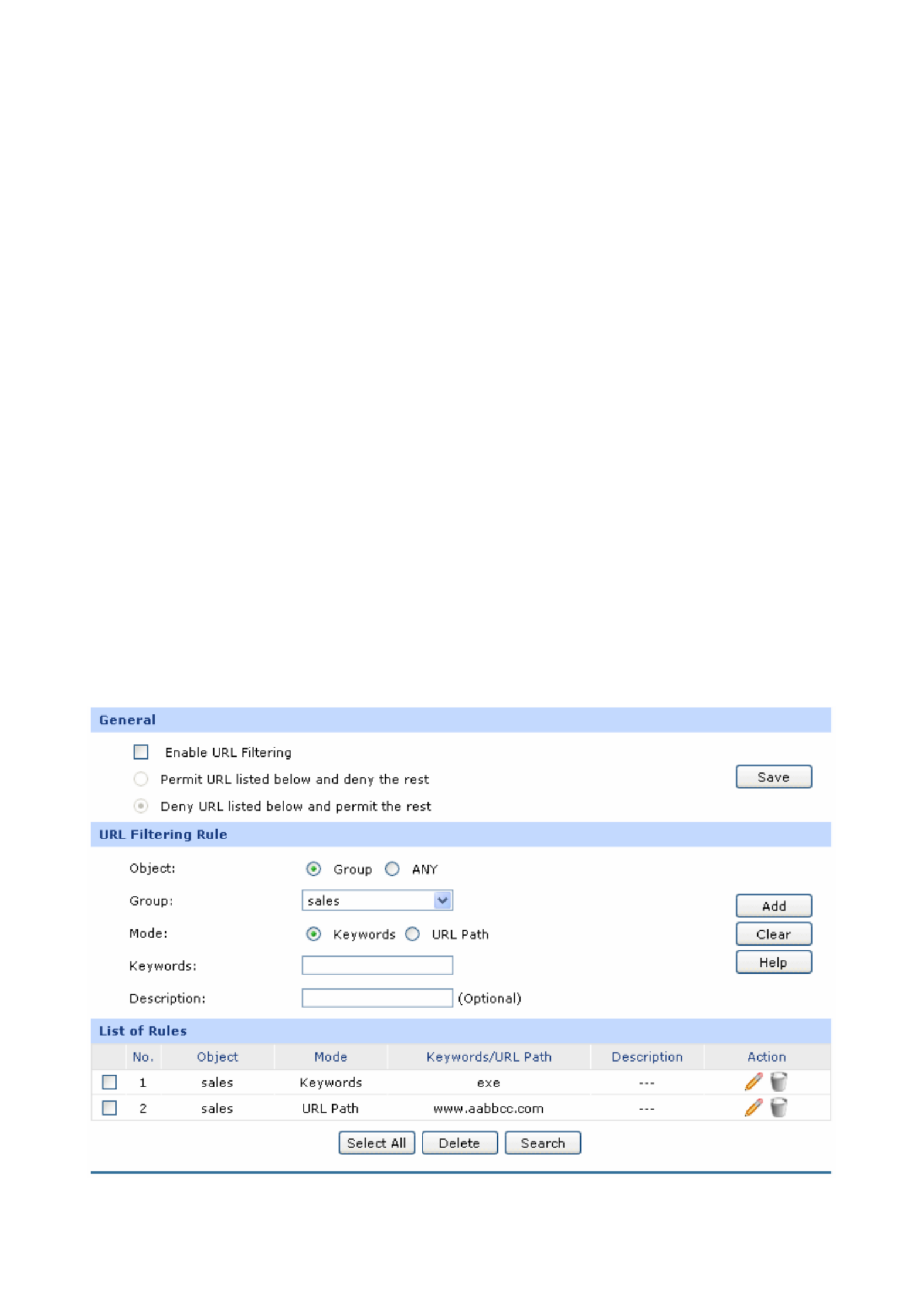
z Group: URL Filtering will take effect to all the users in group.
Mode: Select the mode for URL Filtering. “Keyword’’ indicates that all the
URL addresses including the specified keywords will be filtered.
“URL Path” indicates that the URL address will be filtered only
when it exactly matches the specified URL.
Description: Give a description for the entry.
¾ List of Rules
You can view the information of the entries and edit them by the Action buttons.
Application Example:
Network Requirements:
Prevent the local hosts from accessing Internet website www.aabbcc.com and downloading the files
with suffix of “exe”.
Configuration Procedure:
Select Keywords mode and type ”exe“ in the field, select URL mode and type “www.aabbcc.com” as
the following figure shows, and then click the <Add> button to make the setting take effect.
-76-
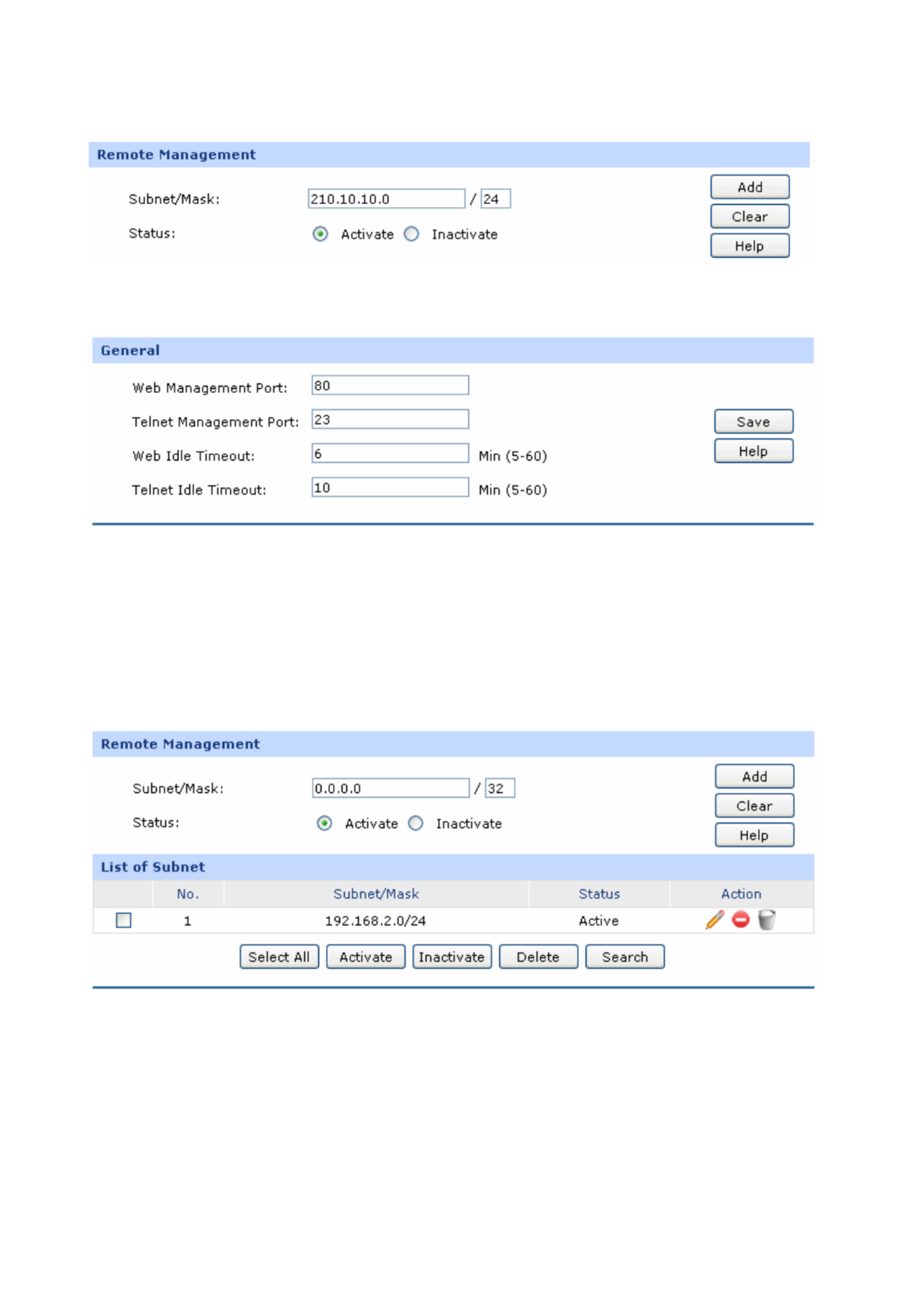
-98-
Type 210.10.10.0/24 in the Subnet/Mask field on Remote Management page and enable the entry as the
following figure shows.
Then type the corresponding port number in Web Management Port and Telnet Management Port fields
as the following figure shows.
Finally, start the web browser and type 210.10.10.50 in the URL field to log in the Web management
page of the Router.
4.8.1.3 Remote Management
On this page you can configure the Remote Management function. This feature allows managing your
Router from a remote location via the Internet.
Choose the menu Maintenance→ →Setup Remote Management to load the following page.
Figure 4-58 Remote Management
The following items are displayed on this screen:
¾ Remote Management
Subnet/Mask: Specify a single IP address or network address for the hosts desired to
access the Router from external network.
Status: Activate or inactivate the entry.
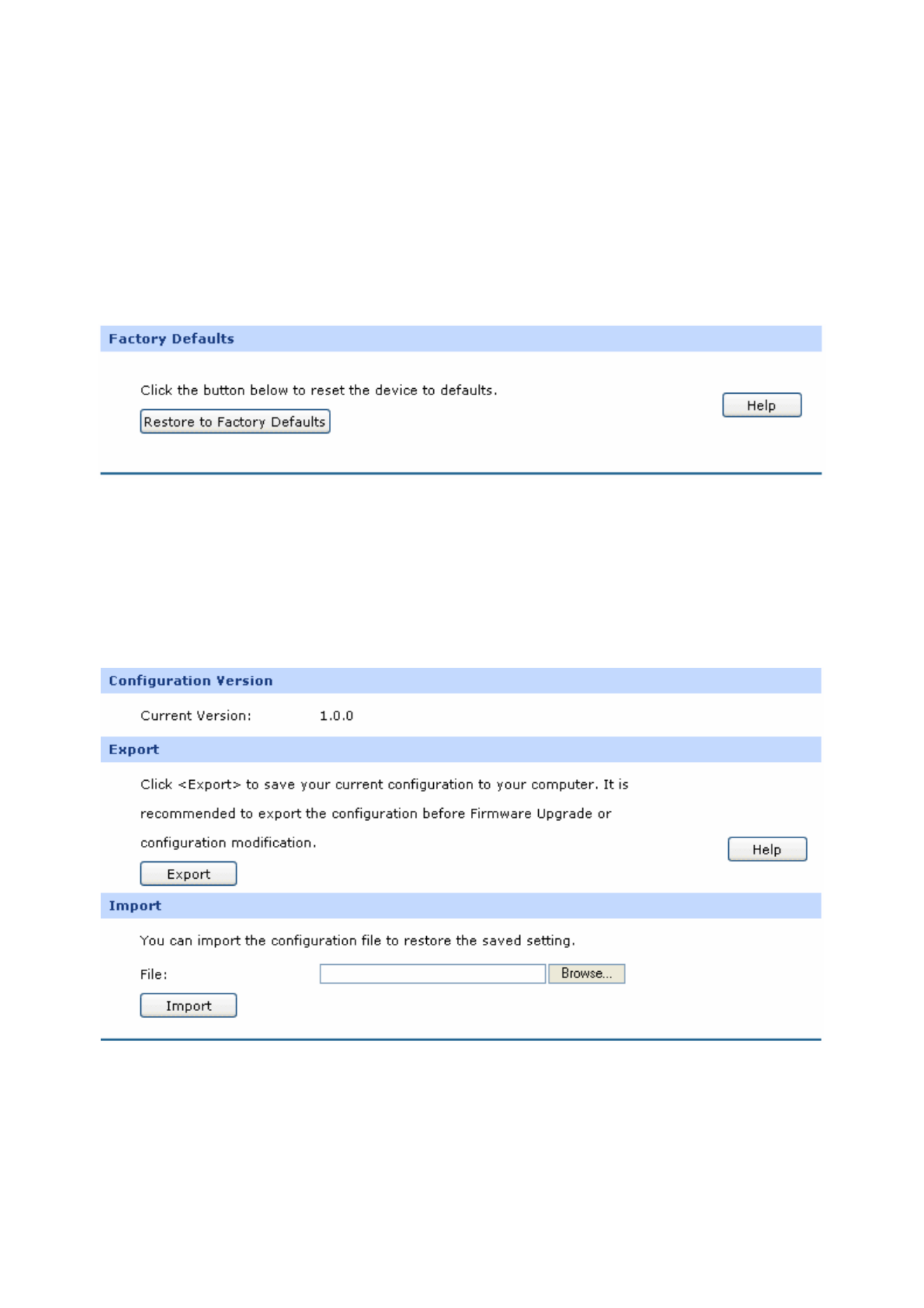
-99-
¾ List of Subnet
In this list, you can view the Remote Management entries and edit them by the Action buttons.
The first entry in Figure 4-58 indicates that: The hosts with IP address in subnet of 192.168.2.0/24 are
allowed to access the Router and this entry is activated.
4.8.2 Management
4.8.2.1 Factory Defaults
Choose the menu Maintenance→ →Management Factory Defaults to load the following page.
Figure 4-59 Factory Defaults
Click the <Restore to Factory Defaults> button to rese to their default values. t all configuration settings
The default IP address is 192.168.0.1; the default login user name and password are both admin.
4.8.2.2 Export and Import
Choose the menu Maintenance Export and Import→ →Management to load the following page.
Figure 4-60 Export and Import
The following items are displayed on this screen:
¾ Configuration Version
Displays the current Configuration version of the Router.

-102-
Interface: Displays the interface.
IP Fragment Rx: Displays the amount of IP Fragments received by WAN port.
Abnormal IP Packets Rx: Displays the rate for transmitting data frames.
4.8.3.2 IP Traffic Statistics
IP Traffic Statistics screen displays the detailed traffic information of each PC on LAN.
Choose the menu Maintenance→Statistics→IP Traffic Statistics to load the following page.
Figure 4-64 IP Traffic Statistics
The following items are displayed on this screen:
¾ General
Enable IP Traffic
Statistics:
Allows you to enable or disable IP Traffic Statistics.
Enable Auto-refresh: Allows you to enable/disable refreshing the IP Traffic Statistics
automatically. The default refresh interval is 5 seconds.
¾ Traffic Statistics
Direction: Select the direction in the drop-down list to get the Flow Statistics o
f
the specified direction.
¾ IP Traffic Statistics
This table displays the detailed traffic information of corresponding PCs.
Sorted by: Select the rule for displaying the traffic information.
4.8.4 Diagnostics
4.8.4.1 Diagnostics
This Router provides Ping test and Tracert test functions for network diagnose.
Produktspecifikationer
| Varumärke: | TP Link |
| Kategori: | Router |
| Modell: | SafeStream TL-R470T+ |
Behöver du hjälp?
Om du behöver hjälp med TP Link SafeStream TL-R470T+ ställ en fråga nedan och andra användare kommer att svara dig
Router TP Link Manualer

19 Oktober 2025

19 Oktober 2025

18 Oktober 2025

17 September 2025
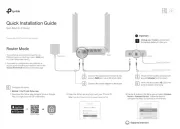
31 Augusti 2025

18 Augusti 2025

26 Juni 2025

25 Juni 2025

25 Juni 2025

27 Januari 2025
Router Manualer
- RDL
- A-NeuVideo
- Medion
- AVM
- Conceptronic
- Bea-fon
- Siemens
- Nexxt
- Wisetiger
- Techly
- CradlePoint
- Cambium Networks
- Mach Power
- Toolcraft
- Manhattan
Nyaste Router Manualer
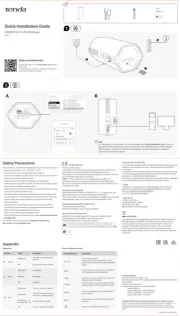
19 Oktober 2025

14 Oktober 2025

13 Oktober 2025
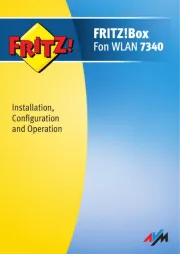
13 Oktober 2025

13 Oktober 2025

9 Oktober 2025

8 Oktober 2025

8 Oktober 2025
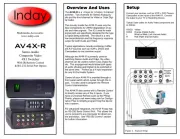
8 Oktober 2025

8 Oktober 2025